NDVI stands for "Normalized Difference Vegetation Index". NRG stands for "Near-infrared / Red / Green". NDVI and NRG are both ways to visualize the amounts of infrared and other wavelengths of light reflected from vegetation. Because both these methods compare ratios of blue and red light absorbed versus green and IR light reflected, they can be used to evaluate the health of vegetation. It's a snapshot of how much photosynthesis is happening. This is helpful in assessing vegetative health or stress. (Read more here: https://www.agronomy.org/publications/jeq/articles/36/3/832) ## Do-It-Yourself These techniques for vegetation analysis were developed for satellite imagery, but at Public Lab, we've been working a lot on capturing infrared imagery using our DIY [near-infrared camera](/wiki/near-infrared-camera) setup, and combining it with visible bands to produce NDVI images such as the one above. ## What these images mean What exactly are these images we're trying to make? What do they tell us about vegetation, and why? These diagrams should help to understand what it is we're doing and why these are good ways to analyze plant life. ## The NDVI equation [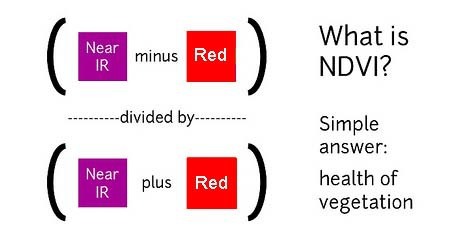](/i/44723) **NDVI = (Near Infrared - Red)/(Near Infrared + Red)** NDVI is a ratio which tries to emphasize photosynthesis while filtering out sun glare. The above equation is run for every pixel, using source data from an infrared photo and a visible light photo, like this pair: [](https://publiclab.org/system/images/photos/000/021/771/original/5390895115_c9d4d38fec_o.jpg) The result can be false-colored to make the high-photosynthesis areas more clear, and used to examine where plants are and how healthy they are. [](https://publiclab.org/system/images/photos/000/021/770/original/PetVISNDVIcomp.png) _Figure above: Normal color photo (right) and normalized difference vegetation index (NDVI) image (left). NDVI image was derived from two color channels in a single photo taken with a camera modified with a special infrared filter. Note that tree trunks, brown grass, and rocks have very low NDVI values because they are not photosynthetic. Healthy plants typically have NDVI values between 0.1 and 0.9. -- @cfastie_ ### Activities Here are a range of activities you can do to produce and interpret your own NDVI imagery, whether downloaded from a satellite imagery provider or [collected yourself using a DIY technique](/wiki/multispectral-imaging) [activities:ndvi] ****   Most DIY converted cameras today (those from Public Lab) use RGN instead of NRG, so the blue channel represents infrared instead of the red channel. That looks like this: [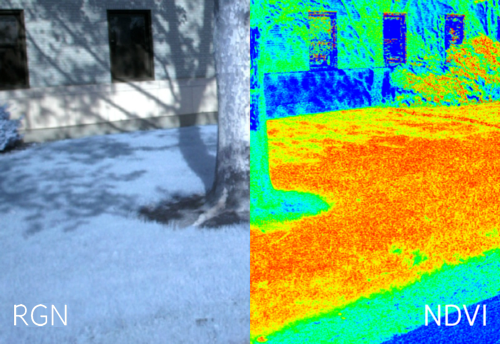](/i/45468?s=o) **** ## NRG imagery Some people are also interested in producing NRG imagery (like the below image), where `Near-Infrared, Red, and Green` are used to compose a picture instead of the usual `Red, Green, and Blue`. [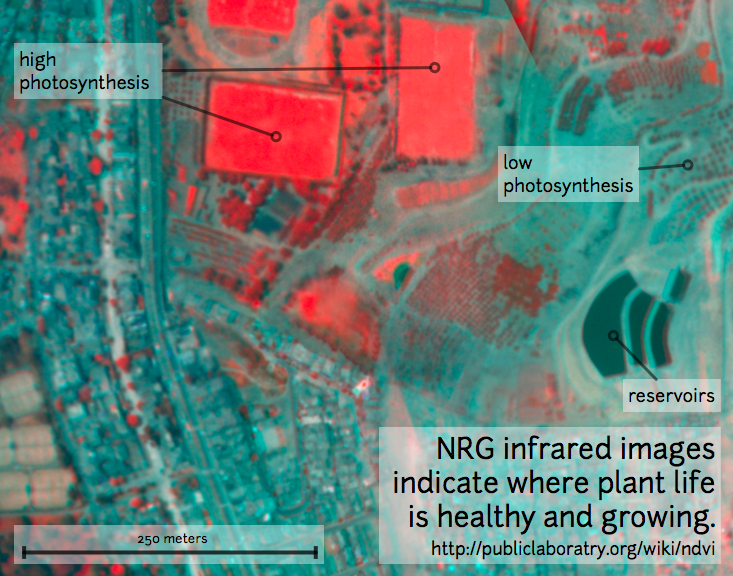](/i/25064) This diagram explains the swapping, which allows us to 'see' infrared as if it were a normal color: [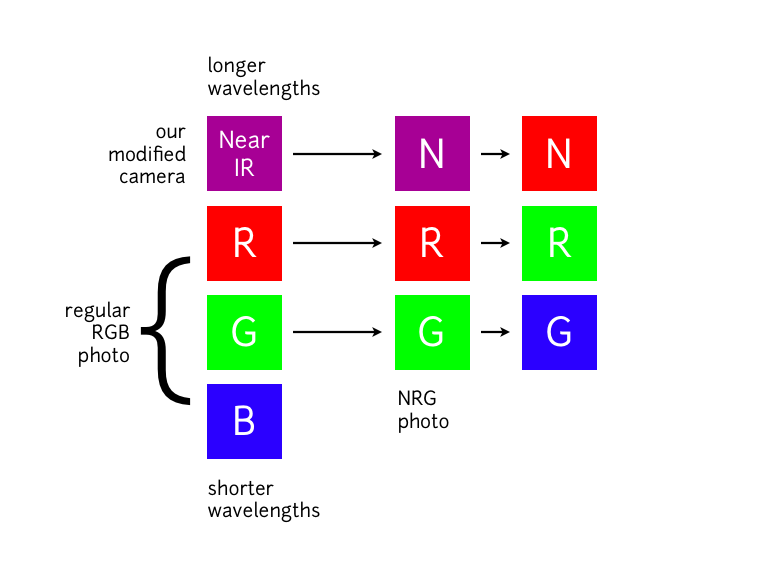](/i/25063) **In NRG images, the deeper and clearer the red color, the denser and healthier the vegetation (more or less).** ### Questions [questions:ndvi] ### Other examples of DIY NDVI imaging From around the internet: Begin watching at 2 minutes to see the resulting imagery: *This topic is part of the [Grassroots Mapping Curriculum](/wiki/mapping-curriculum) series.* **** [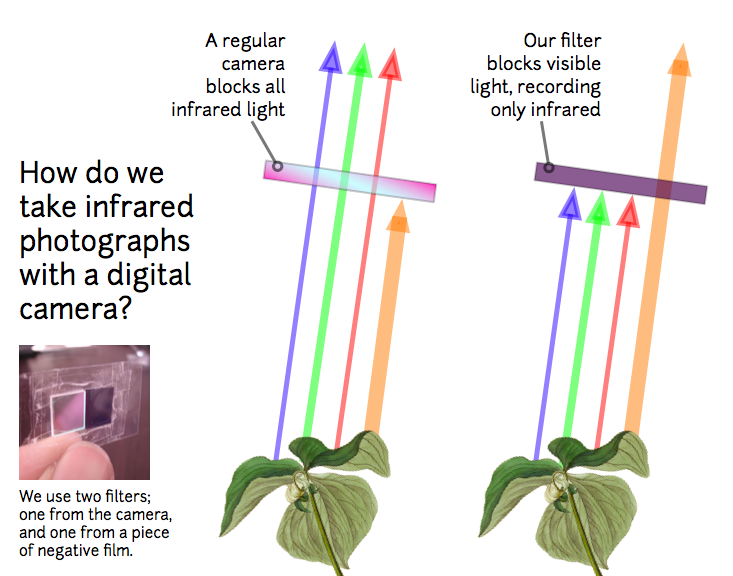](/i/25066) [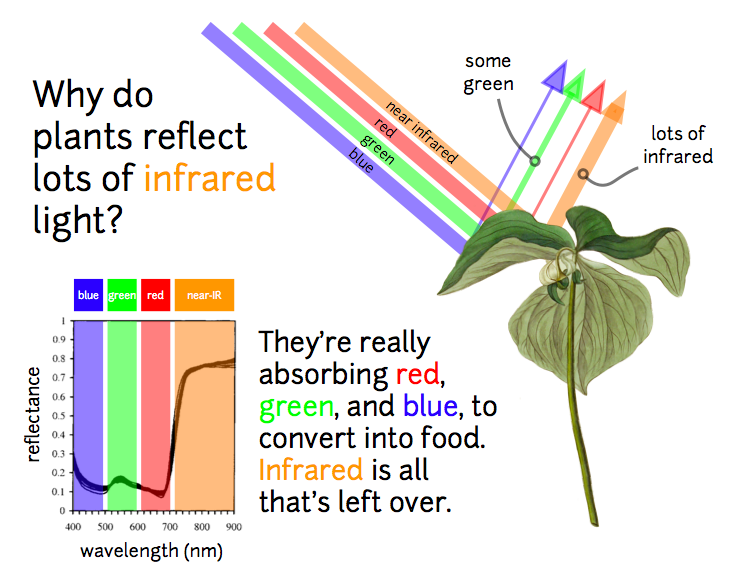](/i/25065) ...
| Author | Comment | Last activity | Moderation | ||
|---|---|---|---|---|---|
| cfastie | "Grayson, The NDVI images look excellent. Just to clarify a few things, I think the following are true: The NIR camera has had its IR block filter..." | Read more » | almost 11 years ago | |||
| radialmind | "Chris, thanks very much, those methods are easier. I think now it's time to redo some of the other tests re: the color balance. I want to see the ..." | Read more » | almost 11 years ago | |||
| cfastie | "Nice photo. The NDVI results look quite believable, even for that complicated scene. In Fiji, when a fresh NDVI image is active, select Process/Ma..." | Read more » | almost 11 years ago | |||
| radialmind | "I can't seem to post photos in the comments, so here's some links to my dropbox. This time I dialed exposure down by -1.66. Then I calibrated white..." | Read more » | almost 11 years ago | |||
| cfastie | "The camera can't distinguish between NIR and other wavelengths, so it assumes that light getting to the blue pixels is mostly blue, light hitting t..." | Read more » | almost 11 years ago | |||
| radialmind | "I agree. I think what the white balance does is basically a custom re-balancing of radiation levels which allows to get correct readings in the end..." | Read more » | almost 11 years ago | |||
| cfastie | "The Fiji plugin doesn't subtract anything, it just assumes you have a visible channel and a NIR channel. Once you remove the IR block filter, there..." | Read more » | almost 11 years ago | |||
| radialmind | "Hi Chris, I keep on experimenting here. I got to see the effects of a grey card in sunlight with AWB. I got a nice lila, poison candy picture from..." | Read more » | almost 11 years ago | |||
| gpenzo | "Hello Chirs. I used a glass filter indeed. They where arround 24 euro. I will use a 3DR Pixhawk to trigger the cameras. The cams do not have gps th..." | Read more » | almost 11 years ago | |||
| cfastie | "We have been hoping that it would be possible to do this in post processing. Put the 18% gray card (or some other card) in the scene and take the p..." | Read more » | almost 11 years ago | |||
| cfastie | "You are going to make a lot of people envious with your lovely crisp images. The NIR photo looks as sharp as the VIS version, so I guess you have a..." | Read more » | almost 11 years ago | |||
| radialmind | "I'm by no means an expert and my results here should be considered empirical and amateur. If the ratio of the amount of radiation between visible a..." | Read more » | almost 11 years ago | |||
| warren | "Wow, those images and the explanation are crystal clear, thank you. Based on what you've learned, what suggestions would you have for improvements ..." | Read more » | almost 11 years ago | |||
| radialmind | "More specific information: http://flightriot.com/ndvi-white-balance-observations-with-cmos-sensors-canon-sx230/ " | Read more » | almost 11 years ago | |||
| radialmind | "Well, reading up on the effect of shadows on NDVI, it certainly doesn't come as a surprise anymore. Here's a page demonstrating C3 technology: htt..." | Read more » | almost 11 years ago | |||
| cfastie | "CMOS sensors seem to handle IR light differently. There as been some limited comparison of CMOS and CCD Powershots. One hypothesis is that the colo..." | Read more » | almost 11 years ago | |||
| radialmind | "Chris, thanks for the kind words. Do you see or would you expect noticeable differences with CMOS vs. CCD? and if so, would you expect them to cont..." | Read more » | almost 11 years ago | |||
| cfastie | "This is a really good result. Why is NDVI artificially high in the shadows? In really dark parts of a photo, the values representing how bright eac..." | Read more » | almost 11 years ago | |||
| patcoyle | "Thanks Chris, excellent feedback and very helpful tips and suggestions. " | Read more » | almost 11 years ago | |||
| cfastie | "Stewart got great NDVI results from his two GoPros, which have CMOS sensors. If you are using a two camera system like that, CMOS is not a problem ..." | Read more » | almost 11 years ago | |||
| cfastie | "I would definitely choose a red filter over blue for NDVI. The comparisons I did in the fall suggest that using a red visible band for visible ligh..." | Read more » | almost 11 years ago | |||
| patcoyle | "Thanks Chris, I'll try to tick through your points, so the discussion is available for all. Got it on E-bay for $9.99. Yes, I do have lots left fo..." | Read more » | almost 11 years ago | |||
| cfastie | "Nicely done. I love the old beat up Kodak packages (but check out this one). Did you get it on eBay? How much? You must have a lot left over for do..." | Read more » | almost 11 years ago | |||
| Roolark | "Ok that's good to know. At the moment, I have a canon ps g12 with the schott bg3 infrablue filter that is saving photos as raw, and my canon dslr r..." | Read more » | almost 11 years ago |